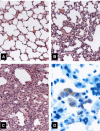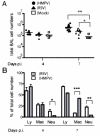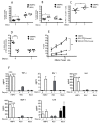Human metapneumovirus induces more severe disease and stronger innate immune response in BALB/c mice as compared with respiratory syncytial virus
- PMID: 17257445
- PMCID: PMC1794227
- DOI: 10.1186/1465-9921-8-6
Human metapneumovirus induces more severe disease and stronger innate immune response in BALB/c mice as compared with respiratory syncytial virus
Abstract
Background: Human metapneumovirus (HMPV) and respiratory syncytial virus (RSV) are members of the Pneumovirinae subfamily of Paramyxoviridae and can cause severe respiratory disease, especially in infants and young children. Some differences in the clinical course of these infections have been described, but there are few comparative data on pathogenesis in humans and animal models. In this study, HMPV and RSV were compared for replication, pathogenesis and immune induction in BALB/c mice infected with equivalent inocula of either virus.
Methods: Viral titers in the lungs and in the nasal turbinates of mice were determined by plaque assay. Histopathological changes in the lungs as well as weight loss and levels of airway obstruction were monitored in the infected mice to record the severity of illness. Inflammatory cells recruited to the lungs were characterized by flow cytometry and by differential staining. In the case of natural killer cells, cytotoxic activity was also measured. Cytokine levels in the BAL were determined by cytometric bead array.
Results: RSV replicated to higher titers than HMPV in the lung and in the upper respiratory tract (URT), and virus elimination from the lungs was more rapid in HMPV-infected mice. Clinical illness as determined by airway obstruction, weight loss, and histopathology was significantly more severe after HMPV infection. A comparison of the cellular immune response revealed similar recruitment of T lymphocytes with a predominance of IFN-gamma-producing CD8+ T cells. By contrast, there were obvious differences in the innate immune response. After HMPV infection, more neutrophils could be detected in the airways and there were more activated NK cells than in RSV-infected mice. This correlated with higher levels of IL-6, TNF-alpha and MCP-1.
Conclusion: This study shows important differences in HMPV and RSV pathogenesis and suggests that the pronounced innate immune response observed after HMPV infection might be instrumental in the severe pathology.
Figures




References
Publication types
MeSH terms
LinkOut - more resources
Full Text Sources
Research Materials
Miscellaneous

